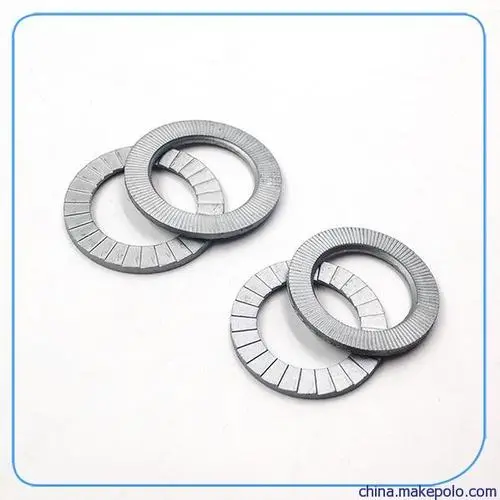RONDELLE DE BLOCAGE
Lock washer is a washer used to prevent nuts or bolts from loosening under vibration or dynamic load. It increases friction or provides mechanical locking force through special structural design or material characteristics, thus ensuring the tightness of the connection.
Advantages of Lock Washer
Efficient locking: The most obvious advantage of lock washer is its excellent locking performance. Compared with ordinary washers, it can effectively prevent bolts or nuts from loosening under complex working conditions such as vibration, impact and dynamic load, and greatly improve the reliability of connection. Lock washer is an important part to ensure safety in some occasions that require high connection stability, such as the connection of high-speed trains and components of aerospace equipment.
Simple installation: The installation method of lock washer is similar to that of ordinary washer, without additional complicated tools or special installation process. In most cases, it is only necessary to install the lock washer together with bolts and nuts to play the role of locking, which makes it easy to popularize and use in various industrial and architectural applications.
Cost-effectiveness: Although the lock washer has excellent locking performance, it is relatively reasonable in cost. Compared with some complicated locking devices (such as special locking nuts or complicated mechanical locking systems), the price of lock washer is relatively close to the people, and at the same time, it can provide good locking effect with high cost performance.
-

Les rondelles de blocage créent une tension en « bloquant » le boulon ou la vis dans le trou fileté de la pièce. Contrairement aux rondelles plates, elles ont des dentelures sur le corps de la rondelle pour empêcher la rotation et fournir une connexion plus sûre que les rondelles plates. Ces rondelles sont fréquemment utilisées dans des environnements soumis à de fortes vibrations pour empêcher le desserrage de l'ensemble de fixation.
Classification of Lock Washers
Outer tooth lock washer: This washer has a toothed structure on its periphery. During installation, the teeth will be embedded in the surface of the connected object. When subjected to external forces such as vibration, the friction between the teeth and the surface of the object can effectively prevent the washer from rotating, thus preventing the bolt or nut from loosening. Generally, there are many kinds of tooth profiles of external tooth lock washers, such as triangular teeth, trapezoidal teeth, etc. Different tooth profiles will have different embedding effect and locking ability.
Internal tooth lock washer: The internal tooth lock washer has teeth on the inner periphery of the washer. These teeth can be closely engaged with the threads of bolts or nuts, and the resistance between teeth and threads can prevent loosening when there is a loosening trend. The advantage of internal tooth lock washer is that it can act on the threaded part of bolt or nut more directly and enhance the locking effect.
Combined lock washer: a lock washer that combines the characteristics of external teeth and internal teeth, or with other locking structures (such as spring structure). For example, there is a combined lock washer, which has teeth that mesh with nuts or bolts inside and teeth that can be embedded into connected objects outside, so that the locking performance is improved greatly.
Working Principle of Lock Washer
Outer tooth lock washer: When the bolt or nut is tightened, the teeth of the outer tooth lock washer will be embedded in the surface of the connected object. In the vibration environment, there is friction between the tooth and the surface, and the embedding direction of the tooth will resist the rotation of the washer, thus preventing the bolt or nut from loosening. For example, in the railway track connection, the teeth of the external tooth lock washer are embedded in the sleepers, which can prevent the track bolts from loosening when the train passes by and produces vibration.
Internal tooth lock washer: its working principle is that the internal teeth are closely meshed with the threads of bolts or nuts. When there is a loosening trend, the internal teeth will generate friction and mechanical resistance with the thread to prevent the rotation of the nut or bolt. For example, in the high-precision connection of mechanical equipment, the internal tooth lock washer can accurately prevent the bolt from loosening due to the tiny vibration inside the equipment, and ensure the accuracy of the equipment.
Combined lock washer: the locking can be realized by the cooperation of internal and external teeth or the cooperation with other structures. The inner and outer teeth provide resistance from different directions, and at the same time, if the spring structure is included, it can also provide additional pre-tightening force in the axial direction by using the elasticity of the spring to further enhance the locking effect. In some occasions with high requirements for locking, such as the connection of aerospace equipment or key components of high-speed trains, this combined locking method can effectively ensure the reliability of the connection.



